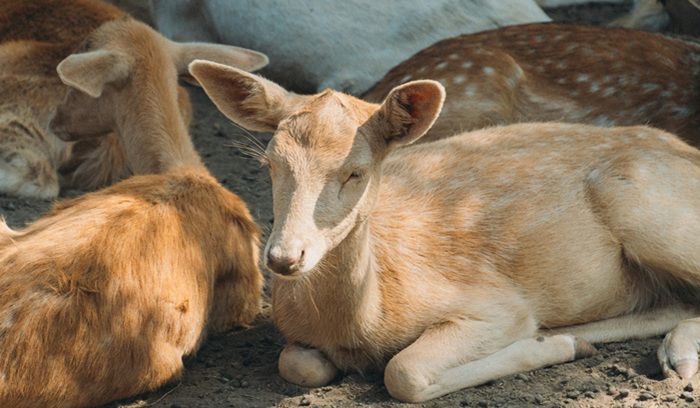The world is celebrating a monumental conservation success: the Pere David’s deer (Elaphurus davidianus) has made a remarkable recovery from near-extinction. This unique species, often called the “milu” or “elaphure,” was saved through decades of dedicated human effort and international cooperation. The global population has rebounded from a low of just 39 individuals to an estimated 8,200 today. This achievement demonstrates the immense power of conservation science and captive breeding programs.
The recovery of this species is a profound victory for biodiversity. It proves that even when a species is functionally extinct in the wild, determined human intervention can bring it back.
The Return from Extinction
The Pere David’s deer was already extinct in its native habitat of China by the time the last global wild population was destroyed by flooding in 1895. The entire surviving population was contained in a private herd in England, gathered by the 11th Duke of Bedford, Herbrand Russell. This small herd of 39 individuals became the sole genetic reservoir for the species. This moment highlights the critical importance of early conservationists who recognized the value of protecting vulnerable species.
This small group was safeguarded at Woburn Abbey. This protection preserved the species while global events, including world wars, unfolded. This initial protection provided the necessary time for future reintroduction efforts.
The Triumph of International Cooperation
The dramatic population rebound is a direct result of decades of strategic international cooperation. The initial breeding program in the United Kingdom successfully increased the herd’s numbers over generations. This led to the establishment of several other herds in zoos and reserves across Europe. These efforts ensured genetic diversity and protected the species from a single catastrophe.
Beginning in the 1980s, a major collaborative effort began to reintroduce the deer to their native homeland in China. The Chinese government, in partnership with the UK, established dedicated nature reserves. These reserves provided protected habitat and the necessary resources for re-establishing wild populations. This successful collaboration is a model for transnational conservation initiatives.
Securing a Resilient Population
The reintroduction of the Pere David’s deer to China was a major success. The deer were initially placed in carefully managed reserves, such as the Beijing Milu Ecological Research Center. These protected environments allowed the population to grow and adapt back to wild conditions. The current population of over 8,200 individuals is stable and genetically healthy.
The recovery ensures the long-term survival of this unique species. The deer, known for their unique features like reversed antlers and webbed feet, are a vital part of their native wetland ecosystem. Their grazing habits contribute to the overall health of the marshlands. This successful reintroduction contributes positively to global biodiversity indices.
A Legacy of Hope and Stewardship
The story of the Pere David’s deer is a powerful legacy of hope and dedicated stewardship. It demonstrates that the worst effects of human impact and natural disasters can be reversed. The survival of the species was entirely dependent on human ingenuity and long-term commitment. The successful reintroduction inspires conservationists working to save other critically endangered species.
The recovery of the milu provides valuable lessons in genetics, habitat restoration, and transboundary cooperation. This victory reinforces the idea that every species is worth saving. The World Wildlife Fund (WWF) highlights the success of species recovery programs globally. The IUCN Red List tracks the status of the species, confirming its move away from critical status.
Resources
- World Wildlife Fund (WWF) on Species Recovery Successes
- International Union for Conservation of Nature (IUCN) Red List Status of Pere David’s Deer
- The Pere David’s Deer Conservation Strategy Overview
- Smithsonian National Zoo on Milu Conservation History
More Good News
-

China’s milu deer achieves stunning population recovery
The world is celebrating a monumental conservation success: the Pere David’s deer (Elaphurus davidianus) has made a remarkable recovery from near-extinction. This unique species, often called the “milu” or “elaphure,” was saved through decades of dedicated human effort and international cooperation. The global population has rebounded from a low of just 39 individuals to an estimated 8,200 today. This achievement demonstrates the immense power of conservation science and captive breeding programs.
-

U.K.’s National Health Service makes morning-after pill available for free in pharmacies across England
England has achieved a major victory for public health by making the morning-after pill free across community pharmacies. This expansion eliminates the significant financial barrier that previously cost patients up to £30. Public health experts predict this policy will lead to a crucial decline in unintended pregnancies. By ensuring immediate and widespread access, the National Health Service (NHS) is actively promoting reproductive autonomy and health equity.
-

Sydney to ban gas and electrify all new big buildings
The City of Sydney has taken a pioneering step toward eliminating fossil fuels from its buildings. The council voted to mandate that all new major buildings must be built all-electric, effectively banning natural gas connections. This major policy shift is critical for accelerating the city’s transition to net-zero emissions. By removing indoor gas pollution, the mandate also creates healthier, safer urban environments for its residents.
-

Nigeria passes major new wildlife trafficking law
A groundbreaking legal reform in Nigeria has created a strong deterrent against illegal wildlife trafficking. The new law increases penalties, targeting the pervasive trade where shipments of pangolin scales alone have reached staggering weights, such as 51 tons in 2019. This decisive action strengthens national enforcement and the capacity of rangers. It provides crucial protection for endangered species like pangolins and forest elephants, reinforcing the commitment to biodiversity in Nigeria and abroad.
-

Nine nations commit to recognizing 395 million acres of Indigenous land by 2030
A landmark international coalition has committed to formally recognizing 395 million acres of Indigenous and traditional community lands worldwide. The nine countries making this pledge are Brazil, Colombia, Costa Rica, Ecuador, Gabon, Guatemala, the Republic of Congo, Peru, and Venezuela. This massive commitment to land tenure security empowers millions of Indigenous and local people to be the primary stewards of their ancestral territories, ensuring the permanent protection of globally vital carbon sinks and biodiversity hotspots.
